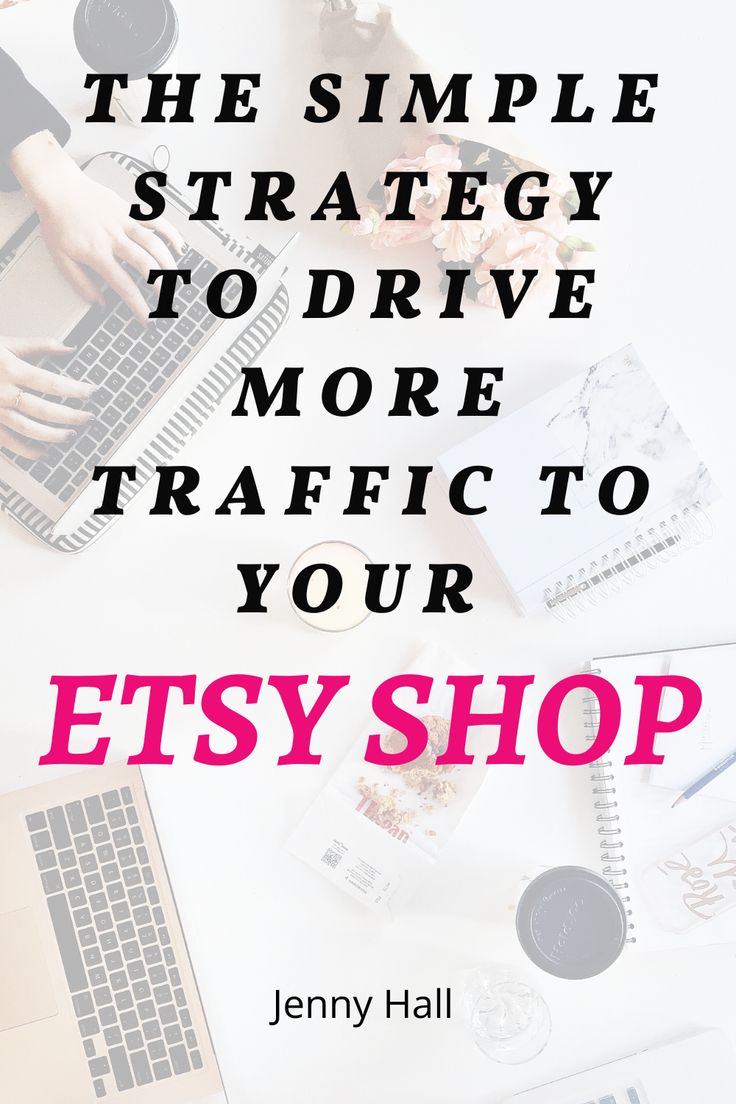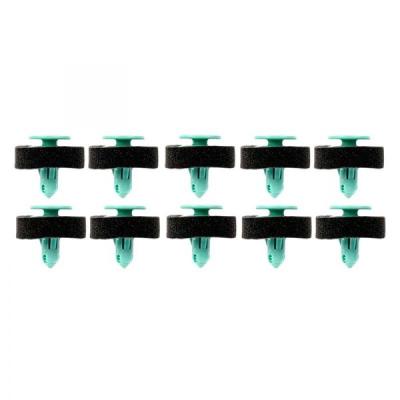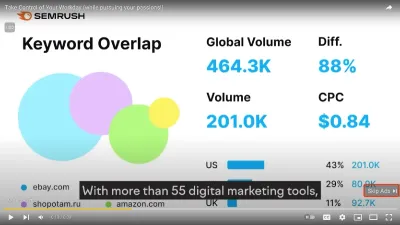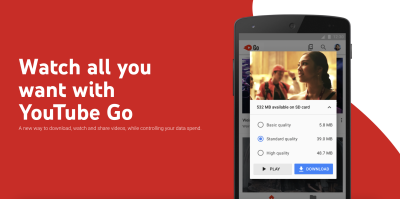Introduction: The Importance of Driving Traffic to Your Etsy Shop
Driving traffic to your Etsy shop is crucial for increasing visibility, attracting potential customers, and boosting sales. Without a steady flow of visitors, even the most well-curated shop can struggle to gain traction.
This section will delve into why traffic is essential, how it influences your shop's performance, and the benefits of having a robust traffic strategy in place. By understanding these fundamentals, you'll be better equipped to implement effective tactics that can elevate your Etsy shop and help you achieve your business goals.
Also Read This: Understanding the Price of My Hero Ultra Rumble
Understanding Your Target Audience

To effectively drive traffic to your Etsy shop, it is essential to have a deep understanding of your target audience. Knowing who your ideal customers are and what they are looking for can significantly impact your marketing strategies and overall shop performance. Here’s a detailed look at how to identify and understand your target audience:
1. Define Your Ideal Customer
Start by creating a profile of your ideal customer. This profile should include demographic details, such as:
- Age: What age group is most likely to buy your products?
- Gender: Are your products more popular with a particular gender?
- Location: Where do your potential customers live? Are there specific regions or countries where your products are in higher demand?
- Income Level: What is the average income level of your target audience? This can help set pricing strategies.
2. Analyze Customer Interests and Preferences
Understanding your audience’s interests and preferences can help tailor your offerings and marketing messages. Consider the following methods:
- Market Research: Use surveys and questionnaires to gather information about what your audience likes and dislikes.
- Competitor Analysis: Study your competitors to see who their customers are and what seems to be working for them.
- Social Media Insights: Utilize social media analytics tools to track engagement and interactions with your content.
3. Utilize Etsy Analytics Tools
Etsy provides a range of analytics tools to help you understand your shop’s performance and audience. Key metrics to focus on include:
| Metric | Description |
|---|---|
| Traffic Sources | Identify where your visitors are coming from, such as search engines, social media, or direct traffic. |
| Popular Listings | See which of your products are attracting the most views and sales. |
| Customer Demographics | Gather information on the age, gender, and location of your buyers. |
4. Create Customer Personas
Develop detailed customer personas based on your research. These personas should represent different segments of your target audience and help you understand their needs, behaviors, and buying motivations. For example:
- Persona 1: “Sarah the Craft Enthusiast” - A 30-year-old woman who loves handmade jewelry and follows crafting blogs.
- Persona 2: “Mark the Collector” - A 45-year-old man who collects vintage items and is active in online collector communities.
By understanding your target audience, you can tailor your marketing efforts, product offerings, and customer engagement strategies to better meet their needs and preferences. This foundational knowledge is key to driving effective traffic to your Etsy shop and achieving long-term success.
Also Read This: Inspiring DIY Handicrafts Ideas to Watch on Dailymotion
Optimizing Your Etsy Shop for Search Engines
Search engine optimization (SEO) is crucial for increasing the visibility of your Etsy shop. By optimizing your shop for search engines, you can improve your shop’s ranking in search results and attract more organic traffic. Here’s how you can effectively optimize your Etsy shop:
1. Keyword Research
Keyword research helps you identify the terms and phrases potential customers are using to search for products similar to yours. Follow these steps:
- Identify Relevant Keywords: Use tools like Google Keyword Planner, Ubersuggest, or Etsy’s own search bar to find relevant keywords.
- Analyze Competitor Keywords: Look at high-ranking competitors to see what keywords they are using.
- Focus on Long-Tail Keywords: These are longer, more specific phrases that are less competitive but highly relevant to your products.
2. Optimize Product Titles and Descriptions
Incorporate your chosen keywords into your product titles and descriptions to enhance their visibility:
- Product Titles: Include primary keywords and make titles descriptive and clear. For example, use “Handmade Silver Necklace with Turquoise Pendant” instead of just “Silver Necklace.”
- Product Descriptions: Write detailed descriptions that include keywords naturally. Highlight unique features, materials, and uses of the product.
3. Use High-Quality Images
Images play a significant role in both user experience and search rankings. Ensure that your images are:
- High Resolution: Use clear, high-resolution images to showcase your products.
- Optimized File Names: Rename image files with descriptive, keyword-rich names before uploading them. For instance, use “handmade-silver-necklace.jpg” instead of “IMG1234.jpg”.
- Descriptive Alt Text: Include descriptive alt text for each image to improve accessibility and provide additional context for search engines.
4. Improve Shop Sections and Titles
Organize your shop into clear sections and use descriptive titles for each section. This helps both customers and search engines understand the structure of your shop:
- Shop Sections: Create relevant sections based on product categories or themes, like “Jewelry” or “Home Décor.”
- Section Titles: Use keyword-rich titles for each section to improve search visibility.
5. Build Backlinks
Backlinks from reputable websites can enhance your shop’s credibility and search rankings. Consider the following methods:
- Collaborate with Bloggers: Reach out to bloggers and influencers who can write reviews or feature your products.
- Participate in Online Communities: Engage in forums and communities related to your niche and include links to your shop when appropriate.
6. Monitor and Adjust
Regularly monitor your shop’s performance using Etsy’s analytics tools and Google Analytics. Track key metrics such as:
| Metric | Description |
|---|---|
| Traffic Sources | See where your visitors are coming from, such as search engines or social media. |
| Keyword Performance | Track which keywords are driving the most traffic to your shop. |
| Conversion Rates | Measure how well your traffic converts into sales. |
By continuously optimizing and refining your Etsy shop, you can improve its search engine ranking, attract more visitors, and ultimately increase sales.
Also Read This: SoundCloud Sync: Getting SoundCloud Songs onto Spotify – A Cross-Platform Connection
Leveraging Social Media to Increase Visibility
Social media is a powerful tool for driving traffic to your Etsy shop and enhancing your shop’s visibility. By effectively utilizing various social media platforms, you can reach a broader audience, engage with potential customers, and boost sales. Here’s a comprehensive guide on how to leverage social media for increased visibility:
1. Choose the Right Social Media Platforms
Select platforms that align with your target audience and the nature of your products. Popular social media platforms for Etsy sellers include:
- Instagram: Ideal for visual content and engaging with a younger audience through photos and stories.
- Facebook: Great for creating business pages, joining relevant groups, and running targeted ads.
- Pinterest: Perfect for showcasing product images and driving traffic through pins and boards.
- Twitter: Useful for real-time updates, engaging in conversations, and sharing promotions.
2. Create High-Quality Content
Content is key to attracting and retaining followers. Ensure your content is:
- Visually Appealing: Use high-quality images and videos that showcase your products effectively.
- Engaging: Create posts that encourage interaction, such as questions, polls, or giveaways.
- Consistent: Maintain a consistent posting schedule to keep your audience engaged and informed.
3. Utilize Paid Advertising
Social media platforms offer various advertising options to reach a targeted audience:
- Facebook Ads: Run ads targeting specific demographics, interests, and behaviors.
- Instagram Promotions: Boost posts or create story ads to reach a wider audience.
- Pinterest Ads: Promote pins to appear in users’ feeds based on their interests and searches.
4. Engage with Your Audience
Building a relationship with your audience can drive loyalty and repeat business:
- Respond to Comments and Messages: Engage with followers by answering questions and acknowledging feedback.
- Host Giveaways and Contests: Encourage participation and increase visibility through interactive promotions.
- Share User-Generated Content: Repost content from satisfied customers to build trust and community.
5. Track and Analyze Performance
Monitor the performance of your social media efforts to optimize strategies:
| Metric | Description |
|---|---|
| Engagement Rate | Measure likes, comments, shares, and overall interaction with your content. |
| Click-Through Rate (CTR) | Track how often users click on links to your Etsy shop from social media posts. |
| Follower Growth | Monitor the increase in followers over time to gauge the effectiveness of your social media strategies. |
By effectively leveraging social media, you can enhance your Etsy shop’s visibility, attract a larger audience, and drive more traffic to your store. Tailor your social media strategies to align with your shop’s goals and continuously adjust based on performance insights.
Also Read This: Exploring the Most Searched Images on Shutterstock: Understanding User Preferences and Trends
Utilizing Paid Advertising for Targeted Traffic
Paid advertising can be a highly effective method for driving targeted traffic to your Etsy shop. By investing in paid ads, you can reach potential customers who are more likely to be interested in your products. Here’s how to make the most of paid advertising to boost your shop’s visibility and sales:
1. Understand Different Types of Paid Advertising
There are several forms of paid advertising that you can utilize to attract traffic:
- Search Engine Ads: Ads that appear on search engine results pages (e.g., Google Ads). They target users who are actively searching for related products.
- Social Media Ads: Ads displayed on social media platforms (e.g., Facebook, Instagram). These can be targeted based on user demographics, interests, and behaviors.
- Display Ads: Banner ads placed on various websites. They can be used to increase brand awareness and drive traffic to your Etsy shop.
- Retargeting Ads: Ads aimed at users who have previously visited your Etsy shop but did not make a purchase. They help remind potential customers of your products.
2. Define Your Advertising Goals
Before starting any advertising campaign, clearly define your goals. Common objectives include:
- Increase Website Traffic: Drive more visitors to your Etsy shop.
- Boost Sales: Increase the number of purchases and overall revenue.
- Build Brand Awareness: Enhance recognition and recall of your brand.
- Generate Leads: Collect email addresses or other contact information for future marketing efforts.
3. Target the Right Audience
Effective targeting ensures your ads reach the most relevant audience:
- Demographics: Target based on age, gender, income level, and education.
- Interests: Use interests and hobbies related to your products to refine your audience.
- Geographic Location: Focus on specific regions or countries where your products are in demand.
- Behavioral Data: Target users based on their past behavior, such as previous visits to your shop or related searches.
4. Create Compelling Ad Content
Your ad content should be engaging and persuasive. Consider the following tips:
- Strong Call-to-Action (CTA): Use clear and compelling CTAs to encourage users to visit your shop or make a purchase.
- High-Quality Visuals: Include eye-catching images or videos that showcase your products effectively.
- Clear Messaging: Ensure your ad copy is concise, informative, and directly addresses the needs or interests of your target audience.
5. Monitor and Optimize Your Campaigns
Regularly analyze the performance of your paid advertising campaigns to ensure they are effective:
| Metric | Description |
|---|---|
| Click-Through Rate (CTR) | Percentage of users who click on your ad after seeing it. |
| Conversion Rate | Percentage of users who complete a desired action (e.g., making a purchase) after clicking your ad. |
| Cost Per Click (CPC) | The average cost you pay for each click on your ad. |
| Return on Ad Spend (ROAS) | The revenue generated for every dollar spent on advertising. |
By carefully planning, targeting, and monitoring your paid advertising efforts, you can effectively drive targeted traffic to your Etsy shop, increase visibility, and ultimately boost sales.
Also Read This: How Big Is Rumble Compared to Other Social Media Platforms
Engaging with Etsy Communities and Forums
Engaging with Etsy communities and forums can be a highly effective way to increase visibility, build relationships, and drive traffic to your Etsy shop. By actively participating in these platforms, you can connect with potential customers, get feedback, and promote your products in a meaningful way. Here’s how to effectively engage with Etsy communities and forums:
1. Join Relevant Etsy Teams
Etsy Teams are groups of sellers who share similar interests or are part of specific geographic locations. Joining these teams can help you:
- Network with Other Sellers: Build connections with other Etsy sellers who can offer support, advice, and collaboration opportunities.
- Participate in Team Activities: Join team challenges, promotions, or events to increase visibility within the Etsy community.
- Get Advice and Tips: Access valuable insights and tips on how to improve your shop and increase sales.
2. Participate in Etsy Forums
Etsy forums provide a platform for sellers to discuss various topics, ask questions, and share experiences. To make the most of forums:
- Be Active: Regularly participate in discussions and offer helpful advice. This will help you build a reputation as a knowledgeable and supportive member.
- Share Your Expertise: Contribute to conversations by sharing your experiences and expertise in areas relevant to your niche.
- Avoid Spamming: Focus on providing value rather than just promoting your shop. Overly promotional posts can be counterproductive and may be flagged by moderators.
3. Engage in Relevant Online Communities
In addition to Etsy-specific forums, there are numerous other online communities where you can engage with potential customers:
- Social Media Groups: Join Facebook groups or Reddit communities related to your niche. Participate in discussions and share your products when relevant.
- Craft and Handmade Forums: Look for forums dedicated to crafts and handmade goods. Engage with members and share your expertise and products.
- Influencer Collaborations: Partner with influencers who can showcase your products to their followers and provide exposure to a wider audience.
4. Host or Participate in Events
Organize or take part in online events to boost your shop’s visibility:
- Webinars and Workshops: Host or join webinars and workshops related to your niche to showcase your expertise and promote your shop.
- Collaborative Projects: Partner with other sellers or artists to create collaborative projects that can be promoted across multiple platforms.
- Giveaways and Contests: Organize giveaways or contests within Etsy teams or other communities to engage users and attract potential customers.
5. Monitor and Evaluate Engagement
Track your engagement activities to assess their effectiveness:
| Metric | Description |
|---|---|
| Engagement Rate | Measure the level of interaction (likes, comments, shares) with your posts and activities. |
| Traffic Referrals | Track how much traffic is coming to your shop from the communities and forums where you are active. |
| Feedback and Reviews | Monitor the feedback and reviews received from community interactions to gauge your impact. |
By actively engaging with Etsy communities and forums, you can enhance your shop’s presence, build valuable relationships, and drive targeted traffic to your Etsy shop.
Also Read This: Discovering the Height of Houston Jones, the YouTuber
Implementing Email Marketing Strategies
Email marketing is a powerful tool for driving traffic to your Etsy shop, nurturing customer relationships, and boosting sales. By leveraging well-planned email marketing strategies, you can effectively engage with your audience, promote your products, and keep your shop top-of-mind. Here’s a comprehensive guide to implementing successful email marketing strategies:
1. Build and Segment Your Email List
A targeted email list is essential for effective email marketing. Follow these steps to build and segment your list:
- Offer Incentives: Provide discounts, free shipping, or exclusive content in exchange for email sign-ups.
- Use Signup Forms: Add signup forms to your Etsy shop, website, and social media profiles to capture leads.
- Segment Your List: Divide your email list into segments based on factors such as purchase history, browsing behavior, or location to send more personalized content.
2. Create Compelling Email Content
Effective email content grabs attention and encourages action. Focus on:
- Engaging Subject Lines: Craft catchy and relevant subject lines to increase open rates.
- Personalized Greetings: Use subscribers’ names and personalize content based on their preferences and past interactions.
- Clear and Attractive Design: Use visually appealing templates with clear calls-to-action (CTAs) to guide recipients towards desired actions.
- Valuable Content: Provide content that is relevant and valuable to your audience, such as product updates, exclusive offers, or useful tips.
3. Automate Your Email Campaigns
Email automation can save time and improve effectiveness. Consider these types of automated campaigns:
- Welcome Emails: Send a series of welcome emails to new subscribers to introduce them to your shop and offer a special discount.
- Abandoned Cart Emails: Remind customers about items left in their cart with a follow-up email and an incentive to complete their purchase.
- Order Confirmation and Follow-Up: Send confirmation emails after purchases and follow up with thank-you notes or requests for reviews.
- Seasonal and Promotional Campaigns: Schedule emails for special occasions, sales, or seasonal promotions to keep your audience informed and engaged.
4. Monitor and Analyze Email Performance
Tracking email performance helps you understand what works and where improvements are needed:
| Metric | Description |
|---|---|
| Open Rate | The percentage of recipients who open your email. A higher open rate indicates effective subject lines and engagement. |
| Click-Through Rate (CTR) | The percentage of recipients who click on links or CTAs within your email. This shows how compelling your content is. |
| Conversion Rate | The percentage of recipients who complete a desired action, such as making a purchase, after receiving your email. |
| Unsubscribe Rate | The percentage of recipients who opt-out of your email list. Monitor this to ensure your content remains relevant and valuable. |
By implementing these email marketing strategies, you can effectively engage your audience, drive traffic to your Etsy shop, and ultimately boost sales. Regularly review and adjust your approach based on performance data to continuously improve your email marketing efforts.
Also Read This: How to Download YouTube Audio A Guide to Extracting Sound from Videos
Analyzing Traffic Sources and Adjusting Strategies
Analyzing traffic sources is essential for understanding how visitors are finding your Etsy shop and optimizing your strategies to increase visibility and sales. By evaluating where your traffic is coming from, you can make informed decisions to adjust your marketing efforts and improve overall performance. Here’s a detailed guide on how to analyze traffic sources and adjust your strategies accordingly:
1. Track Traffic Sources
Start by identifying the various sources of traffic to your Etsy shop:
- Direct Traffic: Visitors who come to your shop by typing your URL directly into their browser.
- Search Engines: Traffic coming from search engines like Google or Bing. This can be further broken down into organic search (unpaid) and paid search (ads).
- Social Media: Traffic from platforms like Facebook, Instagram, Twitter, or Pinterest. Track engagement and referral links from these platforms.
- Referral Traffic: Visitors who arrive at your shop through links from other websites or blogs.
- Email Campaigns: Traffic generated from email marketing campaigns, including newsletters and promotional emails.
2. Use Analytics Tools
Leverage analytics tools to gather data on your traffic sources:
- Etsy Shop Stats: Use Etsy’s built-in analytics to view traffic sources, popular listings, and customer demographics.
- Google Analytics: Integrate Google Analytics with your Etsy shop to get detailed insights into traffic sources, user behavior, and conversion rates.
- Social Media Insights: Utilize analytics provided by social media platforms to measure the effectiveness of your social media campaigns and track referral traffic.
3. Analyze Traffic Data
Evaluate the data to understand which sources are most effective:
- Identify Top Traffic Sources: Determine which sources drive the most visitors to your shop and focus on optimizing those channels.
- Measure Conversion Rates: Analyze how well traffic from different sources converts into sales. For example, compare conversion rates from social media vs. search engines.
- Evaluate User Behavior: Assess how visitors from different sources interact with your shop, such as average session duration and bounce rates.
4. Adjust Your Strategies
Based on your analysis, make adjustments to improve your traffic and sales:
- Optimize High-Performing Channels: Invest more in channels that drive high-quality traffic and have better conversion rates.
- Improve Low-Performing Channels: Reevaluate and enhance strategies for channels with low performance. This could involve changing your approach or increasing engagement efforts.
- Experiment with New Channels: Explore new traffic sources, such as emerging social media platforms or new advertising opportunities.
5. Monitor and Iterate
Regularly monitor your traffic sources and adjust your strategies based on ongoing data:
| Metric | Description |
|---|---|
| Traffic Volume | The total number of visitors coming from each source. |
| Conversion Rate | The percentage of visitors who make a purchase or complete a desired action. |
| Engagement Metrics | Indicators such as session duration, page views per visit, and bounce rate. |
By effectively analyzing your traffic sources and making data-driven adjustments, you can enhance your marketing efforts, drive more targeted traffic to your Etsy shop, and achieve better results.
Also Read This: Can You Screen Record YouTube Videos?
FAQ: Common Questions About Driving Traffic to Etsy Shops
Driving traffic to your Etsy shop is essential for increasing visibility and boosting sales. Here are some common questions and answers to help you navigate the process more effectively:
1. How can I improve my Etsy shop's visibility?
Improving your Etsy shop's visibility involves several strategies:
- Optimize Your Listings: Use relevant keywords in your titles, descriptions, and tags to improve search rankings.
- Enhance Your SEO: Implement SEO best practices for both Etsy and external search engines.
- Utilize Social Media: Promote your shop on platforms like Instagram, Facebook, and Pinterest to reach a broader audience.
- Engage with Communities: Participate in Etsy teams and online forums related to your niche.
- Run Paid Ads: Invest in targeted advertising on platforms like Google and social media to drive traffic to your shop.
2. What are the best ways to use social media to drive traffic?
To leverage social media effectively:
- Create Engaging Content: Share high-quality images, videos, and stories about your products.
- Use Paid Promotions: Run targeted ads on platforms like Facebook and Instagram to reach potential customers.
- Engage with Followers: Respond to comments, participate in conversations, and host giveaways or contests.
- Track Performance: Use analytics tools to monitor engagement and adjust your strategies based on performance data.
3. How important is email marketing for driving traffic?
Email marketing is crucial for:
- Building Relationships: Keep your audience engaged with personalized content and exclusive offers.
- Driving Repeat Business: Send follow-up emails, product recommendations, and special promotions to encourage repeat purchases.
- Segmenting Your Audience: Target different segments of your email list with tailored messages based on their interests and behaviors.
4. What metrics should I monitor to assess traffic effectiveness?
Key metrics to track include:
| Metric | Description |
|---|---|
| Traffic Sources | Identify where your visitors are coming from (e.g., search engines, social media, referrals). |
| Conversion Rate | Measure the percentage of visitors who complete a desired action, such as making a purchase. |
| Engagement Rate | Track how users interact with your content, including clicks, likes, and shares. |
| Return on Investment (ROI) | Calculate the revenue generated from your marketing efforts compared to the costs. |
5. How can I adjust my strategies based on traffic analysis?
To optimize your strategies:
- Focus on High-Performing Channels: Allocate more resources to traffic sources that drive the most conversions.
- Improve Low-Performing Channels: Revise strategies for underperforming channels to enhance effectiveness.
- Experiment with New Methods: Test new marketing tactics or platforms to discover additional opportunities for driving traffic.
- Monitor Trends: Stay updated on industry trends and adjust your approach to align with changing market conditions.
By addressing these common questions and applying the provided strategies, you can effectively drive more traffic to your Etsy shop and enhance your overall performance.
Conclusion: Summarizing Key Strategies for Traffic Growth
Driving traffic to your Etsy shop is essential for increasing visibility, attracting potential customers, and ultimately boosting sales. By employing a range of strategies, you can effectively enhance your shop's reach and performance. Here’s a summary of key strategies for traffic growth:
1. Optimize Your Etsy Shop for Search Engines
Ensure your shop and listings are optimized for search engines to improve visibility:
- Use Relevant Keywords: Incorporate relevant keywords into titles, descriptions, and tags.
- Improve Listing Quality: Utilize high-quality images and detailed descriptions to attract and retain visitors.
- Leverage SEO Best Practices: Apply both Etsy-specific and general SEO techniques to enhance your shop’s search ranking.
2. Leverage Social Media
Utilize social media platforms to engage with a broader audience:
- Create Engaging Content: Share visually appealing and relevant content to capture attention.
- Utilize Paid Advertising: Invest in targeted ads to reach potential customers more effectively.
- Engage with Your Audience: Respond to comments and messages, and actively participate in social media communities.
3. Implement Effective Email Marketing
Email marketing remains a powerful tool for driving traffic:
- Build and Segment Your List: Grow your email list and segment it for personalized messaging.
- Create Compelling Content: Craft engaging and relevant email content to encourage opens and clicks.
- Automate Campaigns: Set up automated email campaigns for welcome messages, abandoned carts, and promotions.
4. Engage with Etsy Communities and Forums
Active participation in Etsy communities can drive traffic and foster connections:
- Join Relevant Teams: Engage with teams and participate in discussions to build relationships.
- Contribute to Forums: Share your expertise and offer valuable insights in forums related to your niche.
- Participate in Events: Host or join events and collaborative projects to increase visibility.
5. Utilize Paid Advertising
Paid advertising can effectively target potential customers:
- Choose the Right Platforms: Select advertising platforms that align with your target audience.
- Define Clear Goals: Set specific objectives for your ad campaigns to measure success.
- Monitor and Adjust: Track performance metrics and refine your strategies based on data.
6. Analyze Traffic Sources and Adjust Strategies
Regularly analyze traffic sources to optimize your strategies:
- Track Key Metrics: Monitor traffic sources, conversion rates, and engagement to understand performance.
- Adjust Based on Data: Reallocate resources to high-performing channels and improve low-performing ones.
- Stay Flexible: Continuously adapt your strategies based on evolving trends and insights.
By integrating these strategies into your marketing efforts, you can effectively drive more traffic to your Etsy shop, engage with a larger audience, and ultimately achieve your sales goals. Remember that continuous evaluation and adjustment are key to sustained success and growth.

 admin
admin








